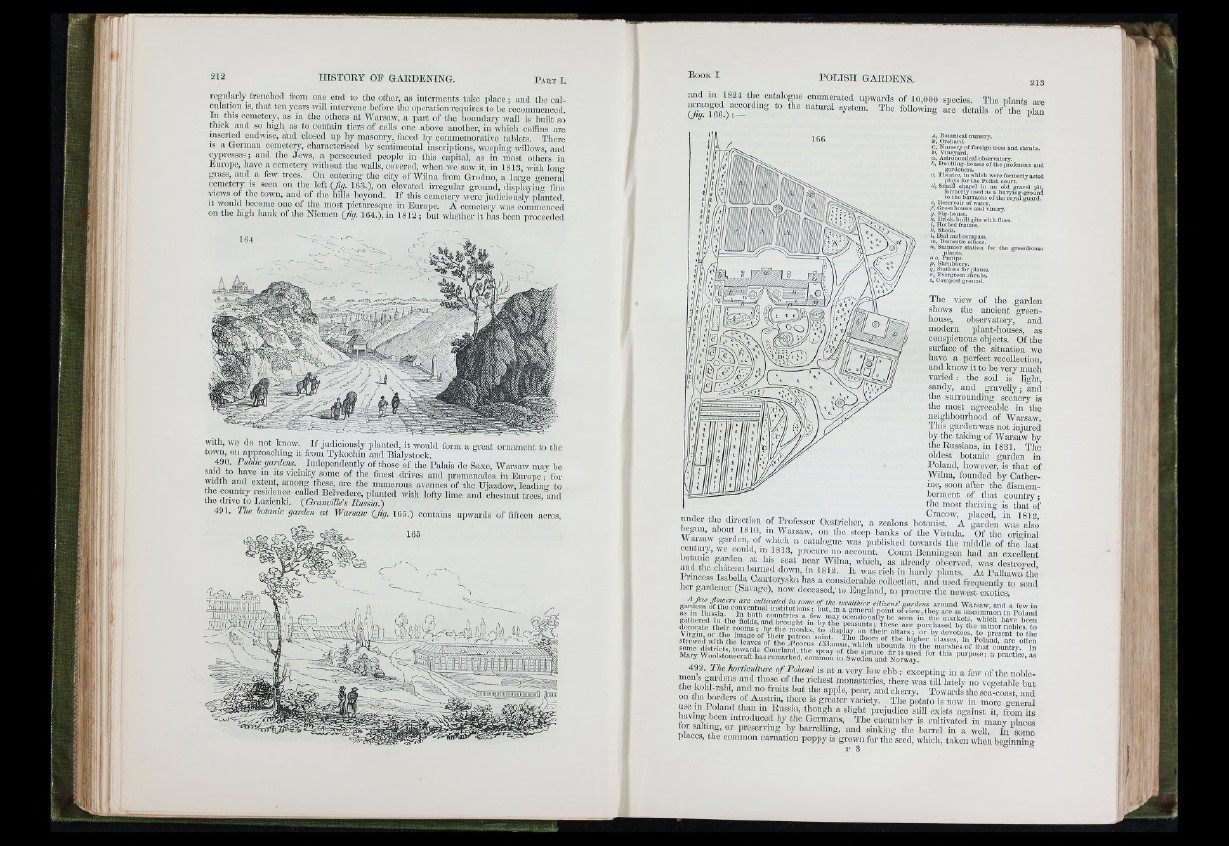
•II . f|l
Ì ‘
regularly trenched from one end to tlic other, as interments take p la ce; and the calculation
IS, that ten years will intervene hcforo the operation reipiircs to be recommenced
111 this cemetery, as iu tho others at AVarsaiv, a part of the boundary ivall is hnilt so
thick and so high as to contain tiers of cells one above another, in wliich coffins arc
inserted endwise, and closed up hy masonry, faced by commemorative tablets. There
IS a Gennan cemetery, characterised by sentimental inscriptions, weeping willows, and
cypresses; and the Jews, a persecuted people in this capital, as in most others in
Europe, have a cemetery without the walls, covered, when wc saw it, in 1813 with long
grass, aiid^ a few trees. On entering tho city of W ilna from Grodno, a large general
cemetery is seen on the left (fig. 16,3.), on elevated iiTcgiilar gi-ound, displaying fine
views ta the town, and of the hills beyond. I f this cemetery were judiciously planted.
It would become one of the most pictiu-csqiie in Europe. A cemetery was commoncca
on tho high bank of tho Niemcn (fis- 164.), in 1812 ; but whether it has been proceeded
with, we do not know. If judiciously planted, it would form a groat ornament to tho
town, on approaching it from Tykochin and Bialystock.
490. Pubhc gardem. Independently of those of tho Palais de Saxe, Warsaw may be
said to have in its vicinity some of the finest drives and promenades in E u ro p e ; for
width and extent, among those, arc the numerous avenues of the Uiazdow, leading to
the country residence c.fikd Belvedere, planted with lofty lime and chestnut trees, and
the drive to Lazienki. (Granville’s Russia.)
491. The botanie garden a t Warsaw (fig. 16,5.) contains upwards of flftoeii acres,
and in 1824 the catalogue enmnerated upwards of 10,000 species. The nlants are
” 6.)“ “ “ " '“ « Tlm fo IW in g L detail! of the plan
A, Botanical nursery.
B, Orcliard.
C, Nursery of foreign trees and slirulis.
D, Vineyard.
a, Astronomical observatory,
i , Dwclliug-houses of the professors and
gardcucrs.
c, Theatre, in which were formerly acted
plays for tlie Polish court.
a, Sinall cliapel in an old gravel p it
formerly used as a burylDg-ground
to the barracks of tlie royal guard.
e, Reservoir of water.
/ , Greoiiliouacs and vinery,
f/, I'ig-houso.
\ Briek-built pits with flues,
i. Hotbed frames.
k. Sheds.
I, Dial and compass.
»n, Domestic ollfces.
»!, Summer station for tho greenhouse
plants.
V, ShrubSory.
q. Stations for plants.
f, Evergreen slirubs.
s, Compost ground.
The view of the garden
shows the ancient greenhouse,
observatoiy, and
modern plant-houses, as
conspicuous objects. Of the
sm-face of the situation we
have a perfect reoollectioii,
and know it to be very much
varied: the soil is light,
sandy, and gravelly; and
tho surrounding scenery is
the most agreeable in the
neighbourhood of Warsaw.
This garden was not injured
by the taking of Warsaw by
the Russians, in 1831. The
oldest botanic garden in
Poland, however, is that of
Wilna, founded by Catherine,
soon after the dismemberment
of that countiy;
tho most thriving is that of
under the direction of Professor Ocsfcriclicr, a zealous botanist, A ''garden was'iilso
begun, about 1810 m Warsaw, on tho steep banks of the Vistula. Of the original
Waisaw garden of which a catalogue was published towards tho middle of the last
cuitiiiy, wc could, in 1813, procure no account. Count Bciiiiiiigsen had an excellent
Mneess T :fbeY T ” ’, “ I’*“ “ '- PuUiawa tlm
i,Gi L ! f i Czartoryska has a considerable collection, and used frequently to send
hei gaidcnei (Savage), now deceased,'to England, to procure tlie newest exotics.
ju jwtrs arc cuitivatea in soni
cultimtcd m some o f tM woaUMer c itize n /g a rd em aroimU Wars,,w. and a few 1
; out, in a eeneral nnini nfvi»w -n-n o» T.ri...
g a rd en s o f th e c o n v e n tu a l in s titu tio n s
as in R u ssia
fîti/uL/w <iiuiiiiu v ïu is aw , a n a
n P o la n d
ft low ol>l>: oxccpting iu a few of the iioblcihe
l o l l 1 ■ V *'! monasteries, there was tiU lately no vegetable but
?onn tthhef lb om drciiesi atai Aa"u“s tria, there is g“rePPa^teOr’ vPaOi“-Lie ty‘™. <* Tolhmo“ p7o- tatToo iws anrodws thine smcao-rceo agsot,l oarnadl
h n lw 1.1 ? ? ™ fto u g h a slight prejudice still exists against it, from its
. ng been mtioduccd by the Germans, The cucumber is cultivated in many plaecs
lor salting, or preserving by barrelling, and sinking the barrel in a well, ¿ some
ptoces, the common carimtion poppy is gro-wn for the seed, which, taken when beginning